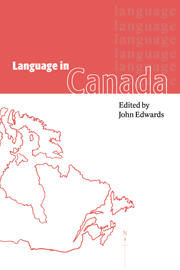Book contents
- Frontmatter
- Contents
- List of figures
- List of maps
- List of tables
- Notes on contributors
- 1 Canada
- Introduction
- 1 The foundations
- 2 The fading Canadian duality
- 3 Official bilingualism: from the 1960s to the 1990s
- 4 Official multiculturalism
- 5 Language in education: bridging educational policy and social psychological research
- 6 Aboriginal languages: history
- 7 Aboriginal languages: current status
- 8 French: Canadian varieties
- 9 French in Quebec
- 10 French in New Brunswick
- 11 French outside New Brunswick and Quebec
- 12 English: Canadian varieties
- 13 English Quebec
- 14 The teaching of international languages
- 15 French immersion in Canada
- 16 Language in Newfoundland
- 17 Language in Prince Edward Island
- 18 Language in Nova Scotia
- 19 Language in New Brunswick
- 20 Language in Quebec: aboriginal and heritage varieties
- 21 Language in Ontario
- 22 Language in Manitoba
- 23 Language in Saskatchewan: Anglo-hegemony maintained
- 24 Language in Alberta: unilingualism in practice
- 25 Language in British Columbia
- 26 Language in the Northwest Territories and the Yukon Territory
- Index of names
- Index of language families, languages, dialects
- Index of subjects
5 - Language in education: bridging educational policy and social psychological research
Published online by Cambridge University Press: 18 February 2010
- Frontmatter
- Contents
- List of figures
- List of maps
- List of tables
- Notes on contributors
- 1 Canada
- Introduction
- 1 The foundations
- 2 The fading Canadian duality
- 3 Official bilingualism: from the 1960s to the 1990s
- 4 Official multiculturalism
- 5 Language in education: bridging educational policy and social psychological research
- 6 Aboriginal languages: history
- 7 Aboriginal languages: current status
- 8 French: Canadian varieties
- 9 French in Quebec
- 10 French in New Brunswick
- 11 French outside New Brunswick and Quebec
- 12 English: Canadian varieties
- 13 English Quebec
- 14 The teaching of international languages
- 15 French immersion in Canada
- 16 Language in Newfoundland
- 17 Language in Prince Edward Island
- 18 Language in Nova Scotia
- 19 Language in New Brunswick
- 20 Language in Quebec: aboriginal and heritage varieties
- 21 Language in Ontario
- 22 Language in Manitoba
- 23 Language in Saskatchewan: Anglo-hegemony maintained
- 24 Language in Alberta: unilingualism in practice
- 25 Language in British Columbia
- 26 Language in the Northwest Territories and the Yukon Territory
- Index of names
- Index of language families, languages, dialects
- Index of subjects
Summary
A brief reflection on ethnic relations in Canada reveals considerable discontent (see Bissoondath, 1994; Edwards, 1994): after several decades, interaction between French and English Canada still reflects ‘two solitudes’, the First Nations continue in their demands for redress for past and present transgressions, and other non-official ethnolinguistic groups press for increased representation in government and education. There has been a variety of attempts by the Canadian federal government to overcome these difficulties. Important here have been language education programmes promoting the harmonious and efficient interaction between citizens from diverse cultural backgrounds. The purpose of this chapter is, therefore, to examine how the socio-political climate influences language learning, directly and indirectly, through language education programmes and policies. By considering socio-educational policy and social psychological research in tandem, we hope to illustrate that not only does policy affect language programmes, language learning and related outcomes, but also that the research on the social psychology of language learning can inform policy and programmes.
Following this goal, the structure of this chapter is two-fold. The first part considers the ramifications of a policy of ‘multiculturalism in a bilingual framework’ for language education in Canada. It is argued that in addition to the traditional pedagogical concerns of developing language competence, this ideology supports an educational orientation relevant to intergroup relations (Diffey, 1995).
- Type
- Chapter
- Information
- Language in Canada , pp. 102 - 124Publisher: Cambridge University PressPrint publication year: 1998
- 8
- Cited by

